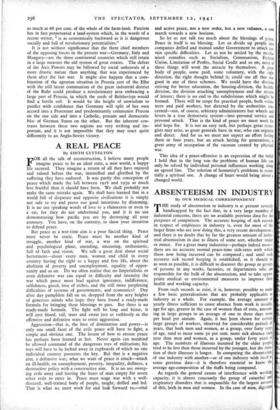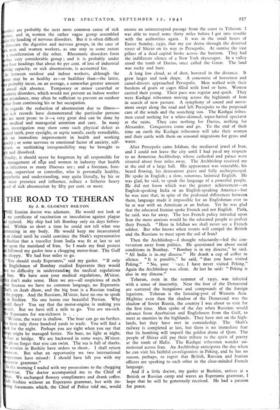ABSENTEEISM IN INDUSTRY
By OUR MEDICAL CORRESPONDENT
THE study of absenteeism in industry is at present severely handicapped by the fact that, in a very large number of industrial concerns, there are no available previous data for the purposes of comparison. The accurate keeping of sick records in respect of employees in industry is, even for most of the larger firms who are now doing this, a very recent development; and there is no doubt that by far the greatest amount of indus- trial absenteeism in due to illness of some sort, whether major or minor. For a great many industries—perhaps indeed most— there are no accurate normal peace-time sick-rates with which those now being incurred can be compared ; and until such accurate sick record keeping is established, as it should be as soon as possible, it is difficult to discover the group or groups of persons in any works, factories, or departments who are responsible for the bulk of the absenteeism, and to take appro- priate medical or environmental measures to improve their health and working capacity.
From such records as exist, it is, however, possible to make a few basic generalisations that are probably applicable to industry as a whole. For example, the average amount of yearly illness sufficient to cause absence from work is usually, age for age, greater in the case of women than of men, amount- ing in large groups to an average of one to three days more per head per annum. Again, it has been shown for certain large groups of workers, observed for considerable periods of years, that both men and women, as a group, over forty yeall of age, tend to incur some 50 per cent. more sick absence each year than men and women, as a group, under forty years of age. The numbers of illnesses incurred by the older people tend to be less than those incurred by the younger, but the dura- tion of their illnesses is longer. In comparing the absenteeism of one industry with another—or of one industry with itself at some previous date—it is therefore essential to know the average age-composition of the Staffs being compared.
As regards the general causes of interference with working capacity, it is almost constantly the group of catarrhal and respiratory disorders that is responsible for the largest amount of this, both in men and women. In the case of men, digestt orders are probably the next most common cause of sick nce, and in, women the rather vague group assembled der the heading of nervous disorders. But it is often difficult dissociate the digestive and nervous groups, in the case of la men and women workers, as one may to some extent a manifestation of the other. Rheumatic disorders form tiler very considerable group ; and it is probably under -e four headings that about 6o per cent, of loss of industrial rking capacity, or sick absenteeism, is accounted for.
As between outdoor and indoor workers, although the mer may be as healthy as—or healthier than—the latter, probably incur, on an average, a somewhat greater amount annual sick absence. Temporary or minor catarrhal or umatic disorders, which would not prevent an indoor worker attendance,- may often be sufficient to prevent an outdoor rker from continuing his or her occupation.
As regards the reduction of absenteeism due to illness— e sick records have demonstrated the particular persons o are most prone to it—a very great deal can be done by medical and managerial attention and care. In many s, investigation may show some such physical defect as ayed teeth, poor eyesight, or septic tonsils, easily remediable, th an immediate improvement in health and working acity.; or some nervous or emotional factor of anxiety, self- trust, or unthinking irresponsibility may be brought to t and dissolved.
Finally, it should never be forgotten by all responsible for management of rrileji and women in industry that health as infectious as many illnesses are ; and a foreman, fore- man, supervisor or controller, who is personally healthy, pathetic and understanding, may quite literally, by his or r mere presence and influence, reduce a hitherto heavy ord of sick absenteeism by fifty per cent, or more.



























 Previous page
Previous page